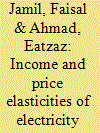| Srl | Item |
| 1 |
ID:
162301


|
|
|
|
|
| Summary/Abstract |
Pakistan faces the perennial issue of electricity theft. The issue deteriorates the financial outlook of utilities and is detrimental to investment in capacity improvement of electricity grid. The solution is generally sought through fiscal injection in capacity enhancement, demand-side management and rationing of electricity. This study investigates the key factors that contributes in electricity theft through structured questionnaires from residential electricity consumers of IESCO in the twin cities of Rawalpindi and Islamabad. A sample size comprise of both rural and urban respondents. The demographic profile and descriptive statistics are discussed. Most of the respondents agree that electricity price hike is the main contributor in rising theft. The crime is taking place with the connivance of bribe accepting utility employees. The correlation analysis is carried out and the data is further used for the empirical estimation of the model. The regression analysis employed key variables such as the conduct of utility employee, consumers’ satisfaction with the service, monitoring, overall consumer perception and the monthly expenses on electricity consumption. The results suggest that monitoring, conduct and monthly expenses variables are significant in explaining electricity theft. These finding suggest an increase in transparency and accountability and a decrease in tariffs to reduce pilferage.
|
|
|
|
|
|
|
|
|
|
|
|
|
|
|
|
| 2 |
ID:
109435


|
|
|
|
|
| Publication |
2011.
|
| Summary/Abstract |
Cointegration and vector error correction modeling approaches are widely used in electricity demand analysis. The study rigorously examines the determinants of electricity demand at aggregate and sectoral levels in Pakistan. In the backdrop of severe electricity shortages, our empirical findings give support to the existence of a stable long-run relationship among the variables and indicate that electricity demand is elastic in the long run to both income and price at aggregate level. At sectoral level, long-run income and price elasticity estimates follow this pattern except in agricultural sector, where electricity demand is found elastic to output but inelastic to electricity price. On the contrary, the coefficients for income and price are rather small and mostly insignificant in the short run. We employed temperature index, price of diesel oil and capital stock at aggregate and sectoral levels as exogenous variables. These variables account for most of the variations in electricity demand in the short run. It shows that mechanization of the economy significantly affect the electricity demand at macro level. Moreover, elastic electricity demand with respect to electricity price in most of the sectors implies that electricity price as a policy tool can be used for efficient use and conservation.
|
|
|
|
|
|
|
|
|
|
|
|
|
|
|
|
| 3 |
ID:
118841


|
|
|
|
|
| Publication |
2013.
|
| Summary/Abstract |
Pakistan is facing severe electricity shortfall of its history since 2006. Several measures have been implemented in order to mitigate electricity shortage. The focus has been on raising the installed capacity of electricity generation and transmission. The present policy results in expensive thermal electricity generation mostly using expensive and environmentally hazardous furnace oil and inability of utilities to recover their cost of supply although there is unprecedented rise in electricity tariffs. This study concentrates on the electricity demand and traces the relationship between electricity shortfalls, tariff rate and electricity theft in the background of recent electricity crisis using the data for the period 1985-2010. We employed the Granger causality test through error correction model and out-of-sample causality through variance decomposition method. Empirical evidence shows that electricity theft greatly influences electricity shortfalls through lowering investment and inefficient use of electricity.
The study concludes that electricity crisis cannot be handled without combating rampant electricity theft in the country.
|
|
|
|
|
|
|
|
|
|
|
|
|
|
|
|
| 4 |
ID:
166492


|
|
|
|
|
| Summary/Abstract |
The study analyzed electricity theft through a three layered principal-agent-client model. The factors that entrench corruption and theft are its beneficial features of lowering the cost of electricity for the consumers and generating private illegal incomes for the corruptible employees. We show that an individual steals electricity only if the subjective pecuniary gains are higher than the associated costs e.g. fine imposed in case of detection or dismissal from job. The study finds that efficiency wages along with higher deterrence and active consumer involvement in reporting the crime can help in combating corruption and pilferage in electricity sector.
|
|
|
|
|
|
|
|
|
|
|
|
|
|
|
|
| 5 |
ID:
098655


|
|
|
|
|
| Publication |
2010.
|
| Summary/Abstract |
This study analyzes the relationship among electricity consumption, its price and real GDP at the aggregate and sectoral level in Pakistan. Using annual data for the period 1960-2008, the study finds the presence of unidirectional causality from real economic activity to electricity consumption. In particular, growth in output in commercial, manufacturing and agricultural sectors tend to increase electricity consumption, while in residential sector, growth in private expenditures is the cause of rising electricity consumption. The study concludes that electricity production and management needs to be better integrated with overall economic planning exercises. This is essential to avoid electricity shortfalls and unplanned load shedding.
|
|
|
|
|
|
|
|
|
|
|
|
|
|
|
|